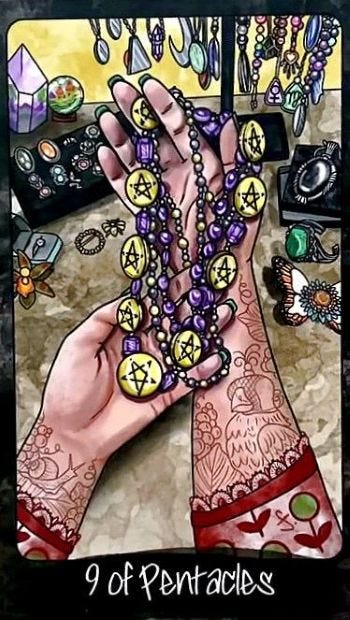🚨Defund the Tarot Police
|
Hi there Tarot Friends, I'm off to MN this week with my brother for a stay on lake Minnetonka. I'm looking forward to being able to see the stars! The second and last eclipse happens next week so hang in there! There are some lovely trines happening in the skies now and through December so be ready to leap once opportunity presents itself. Date with Tarot-Second MeetingMissed the first meeting? Find it here. The Snapshot MethodObjective: Practice connecting with your eyes. Learn to take in the image on the card without jumping to meaning. Note: Tarot decks vary in their imagery. Therefore, the information contained in the 4 of cups, for instance, is going to vary from deck to deck. Remember, we are putting definitions aside for the duration of the course. So just go with it!
Step 1Look at a card from your daily draw. 👀Describe what you see. [Not what it means. What you see.]
Write down 2–3 sentences as if you’re narrating a picture book. Example: Two hands with palms facing up are holding a purple beaded necklace with pentacles strung in between the purple beads. The hooded falcon from the RWS appears as a tattoo on the inside of the woman’s arm holding the necklace. There is a table with more jewelry and crystals. It looks like a market set up. That’s it. You just did it. I can’t because:
Something to ConsiderAll the different Tarot decks in existence are just riffing on the cards that came before them. If Tarot cards and “definitions” are finite, static, and immovable, how is that possible? And if it’s okay to riff your own Tarot deck, why would it not be okay to riff your own “definitions” or correspondences? Step 2Now take one element from your description and use it to title the card you are looking at. Examples:
The title is not a “definition”. It’s a way to discover the card using your own senses. This anchors the image in your memory without memorizing a definition list. It’s one way among many to create your own Tarot card correspondences, your own keywords to pull on at a moment’s notice. How to measure success
That’s it. 3 points max. Step 3Continue to pull a card or two at the beginning of the day and write 2-3 lines about the card(s) you pulled. Use this lesson as your guide. Go back and reflect at the end of the day writing 2-3 lines about what you encountered in your day. Don’t worry about matching anything up with the cards. Just write it down.
Summary Sometimes Tarot shows up mysterious, sometimes obvious, sometimes a total trickster. But you don’t have to figure it all out yet. Just notice what’s in front of you. How many times did you pull cards last week? Even if it was zero, it’s not to late to start your practice. See you next week, where we’ll keep building the habit of the daily draw and deepen the conversation. -Cassandra the Card Reader |


